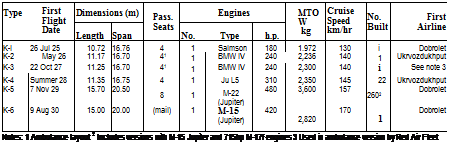Kalinin

M-22 (1 х 480hp) ■ MTOW 3,600kg (7,9001b) ■ Normal Range 820km (500mi) ■ Length 16m (52ft) ■ Span 20m (66ft)

The Elliptical Wing
Some Kalinin aircraft pictures strongly suggest Dornier ancestry, and clearly the designer drew some inspiration from the German company, which was closely associated with Ukrvozdukhput, the Ukrainian airline which was based at Kharkov, and used Dornier Komets, some of which were assembled in its workshops. Kalinin shared floor space in these shops.
But in one important respect, the Kalinin aircraft differed. Whereas both the leading and the trailing edge of the Dornier and Merkur aircraft were parallel, a plan view of the Kalinin wing showed an almost perfect ellipse.
Early work
Konstantin Alekseyevich Kalinin was born in December 1889 at Valuki, near Kharkov. In 1905 he was arrested for suspected revolutionary activities, but by 1912 he had entered the Military School at Odessa. After serving in the Russian Army in the Great War, he entered the Air Training School at Gatchina, near Petrograd, in 1916. When the 1917 Revolution broke out, he was with the 26th Corps Aviation Squadron on the Romanian front. Emerging from the civil war, he studied aviation, first at the Red Army’s Aviation Institute, then at the prestigious Zhukovskiy Academy.
After many a brush with bureaucratic interference, Kalinin was finally able to design his first aircraft, aided by some like-minded friends at Kiev. The K-l made its first flight on 26 July 1925, was flown to Moscow on 11 April 1926, and used by Dobrolet for crop-spraying, aerial photography, and as an air ambulance. Kalinin then transferred his base to Kharkov, and successive designs followed (see table), using all-metal construction, rather than welded steel framework, with wood and fabric.
The Kalinin K-4
During the summer of 1928, Kalinin demonstrated the moderately successful K-4, which was not used for passengers until the summer of 1929.
But on 27 June 1929, the K-4 inaugurated service on the important route from Moscow to Tashkent; and in August, the Chervona Ukraina (Heart of Ukraine), piloted by M. A. Chyegirev, demonstrated its performance and reliability by flying round-trip from Kharkov to Irkutsk, via
KALININ TYPES USED IN SERVICE
Moscow, a distance of 10,800km (6,700mi). Twenty-two K-4s were built and used extensively on Dobrolet’s routes until the early 1930s.
The Kalinin K-5 and the End of the Line
Kalinin’s finest aircraft was the K-5, first flown by Chyegirev on 7 November 1929. It had various engines, the Russian 450hp M-15 (for the prototype), the Pratt & Whitney Hornet, the 480hp M-22 radial based on the Bristol Jupiter, and the 730hp M17F water-cooled in-line, which gave the K-5 a cruising speed of 170km/h (105mph). Of welded construction, it had dual controls, a toilet, and baggage compartment. It could fly across the Caucasus, reducing the Moscow – Tblisi distance by several hundred miles. Two hundred and sixty aircraft were built, retiring only at the beginning of the Great Patriotic War in 1941.
As shown in the table, Kalinin built other types after the K-5, but none went beyond the prototype stage. Of special mention is the K-7, a seven-engined twin-boom monster, designed to carry 120 passengers. Chyegirev first flew it on 11 August 1933, made a few test flights, then crashed on its ninth flight on 21 November, killing him and 14 of the total of 20 on board. Seven years later, Kalinin himself was to die on 24 April 1940, a victim of Stalin’s purges.











